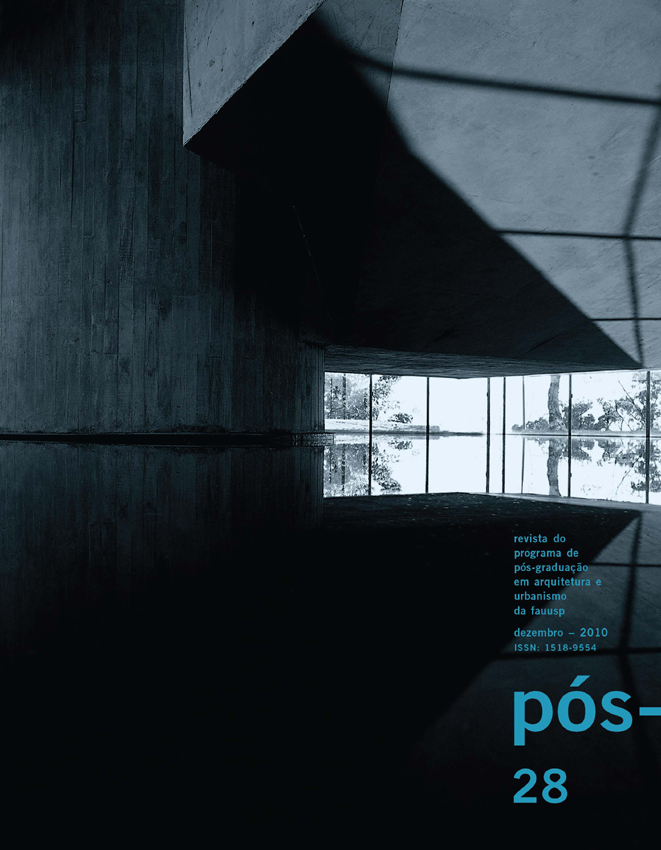Sustainability of the housing of the amazon rubber tapper
DOI:
https://doi.org/10.11606/issn.2317-2762.v0i28p182-197Keywords:
Acre, Amazon, forest, housing, rubber gatherer, latex collector, sustainabilityAbstract
This article, focusing on construction technology, investigates and identifies the sustainability of the Amazon rubber tapper's home, built within the rubber tree forest of the Brazilian State of Acre from the late 19th century to the second half of the 20th century. This study also surveys bibliographical information, historical, determinant and constructive facts that attributed meanings to this model of construction, identifying it as sustainable housing. The latex collector was a crude individual, usually a migrant from the country's Northeast, driven by the droughts in the Northeastern backwoods, in search of wealth. When these people reached the Amazon regions to tap rubber trees and produce rubber, they entered the dense and lush forests, rich in rubber trees, Brazil nut trees, bamboo, palm trees and all types of hardwood. It was an unknown world. As a result of a war for latex hegemony, Acre emerged as important to Brazil and the whole world. Lacking a good financial situation and due to the basic needs and memories of their homeland, the rubber tappers built their houses similar to the Amazon native's housing, using raw materials from the forest - such as wood, paxiúba, palm straws, cipó and bamboo - without destroying the environment. They learned how to protect their homes from the storms by interacting with nature through open, integrated and windy spaces. These findings are based on the history of Acre's settlement, and the descriptions of the tappers' homes are evidence of dwellings that are fully self-sustainable.Downloads
References
ABREU, Estela dos Santos; TEIXEIRA, José Carlos de Abreu. Apresentação de trabalhos monográficos de conclusão de curso. 9. ed. rev. ampl. Niterói: EdUFF, 2007.
ACRE (Estado). Memorial dos autonomistas. Rio Branco: Centro Histórico de Rio de Branco, 2008.
BURSZTYN, Marcel (Org.); FILHO, Argemiro Procópio; CAMPOS, Arminda E. Marques et. al. Ciência, ética e sustentabilidade. 3. ed. Brasília: Cortez/Unesco, 2002.
CORONA & LEMOS. Dicionário da arquitetura brasileira. São Paulo: 1. ed. Edart-Livraria Editora Ltda, 1972.
CUNHA, Euclides da. Comissão mista brasileiro-peruana: Extrato do relatório da comissão mista brasileiro-peruana de conhecimento do Alto Purus. Acervo: Arquivo Histórico do Itamaraty. Rio Branco-Acre: Printac, 2006.
FURASTÉ, Pedro Augusto. Normas técnicas para o trabalho científico: Elaboração e formatação. Explicação das normas da ABNT. 14. ed. Porto Alegre: [s.n.], 2006.
IBAMA. Instituto Brasileiro do Meio Ambiente e dos Recursos Naturais. Rio Branco. Disponível em: ibama@ac.gov.br. IBGE. Intituto Brasileiro de Geografia e Estatística. Disponível em: htpp://www.ibge.gov.br/home. Acesso em: set. 2010.
INCRA. Intituto Nacional da Reforma Agrária. Brasília: Incra, 2008.
LEMOS, Carlos A. C. O que é arquitetura. São Paulo: Brasiliense, n. 16, 2003. (Coleção Primeiros Passos)
LIMA, M. F. O Acre – Seus aspectos físicos e geográficos, sócio-econômicos, históricos e seus problemas. Rio Branco: [s.n.], v. 1, s/d.
LOBÃO, M. S.; PEREIRA, K. R. M. Propriedades físicas e mecânicas da madeira. Rio Branco: Universidade Federal do Acre/Departamento de Ciências Agrárias, 2005.
NEVES, Marlúcia Cândida de Oliveira. A colocação e a casa do seringueiro: Exemplo de arquitetura vernácula da Amazônia. Rio Branco: Gráfica TJ/AC, 2007
RANGEL, Armando J Velázquez. Indicadores de evolución de la sustentabilidad de proyectos de viviendas. Disponível em: velásquez@fc.uclv.edu.cu.
SECRETARIA ESTADUAL DE FLORESTA (SEF). Disponível em: floresta@ac.gov.br.
SECRETARIA MUNICIPAL DE MEIO AMBIENTE (SEMEIA). Disponível em: semeia@ac.gov.br.
SILVA, Pedro Paulo de Lima et. al. Dicionário brasileiro de ciências ambientais 2. ed. Rio de Janeiro: Thex Ed., 2002.
SOUSA, A. M. de. Desbravando a Amazônia ocidental brasileira: Estudo toponímico de acidentes humanos e físicos acreanos. 2007. 143 p. Tese (Doutorado) – Universidade Federal do Ceará, Fortaleza, 2008.
SOUZA, C. A. A. de. História do Acre: Novos temas, nova abordagem. Rio Branco: Carlos Alberto Alves de Souza, 2002-2005.
TOCANTINS, Leandro. Formação histórica do Acre. 4. ed. Brasília: Senado Federal, Conselho Editorial, v. I, 2001. (Coleção Brasil 500 anos)
TOZONI, Reis; CAMPOS, Marília Freitas de. Metodologia de pesquisa. Curitiba: IESDE Brasil S. A., 2005.
Downloads
Published
Issue
Section
License

This work is licensed under a Creative Commons Attribution 4.0 International License.
DIADORIM - Diretório de Políticas Editoriais












